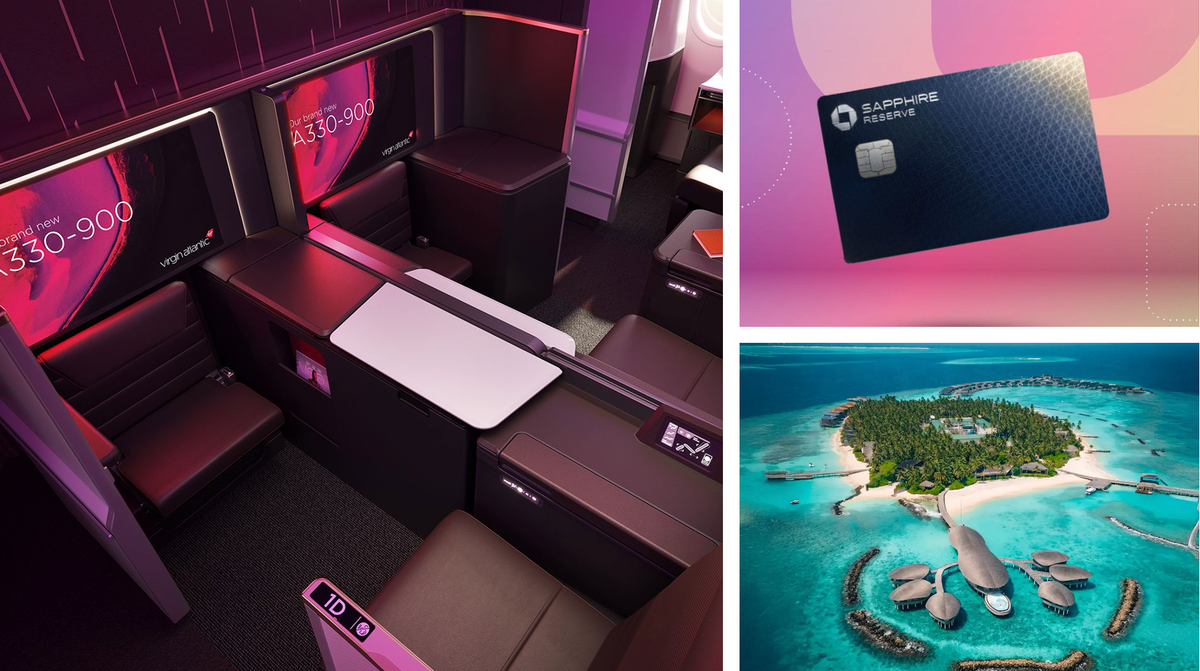What 500,000 Chase Points Can REALLY Get You (It’s Not What You Think)
500k Chase UR points unlock elite travel: fly First Class globally, stay in 5-star hotels, or book a full year of luxury trips. Think $15K+ in value from ANA Suites & Emirates First to Park Hyatt stays. With smart planning, it's a passport to world-class experiences few ever touch.


If You Only Had 60 Seconds to Read This Article (Click Here)
With 500,000 Chase UR points, you unlock $7,500 in portal value (1.5¢/pt with Sapphire Reserve), but $15,000+ in travel value is possible via strategic transfers. You can book multiple first class flights (e.g., Singapore Suites round-trip at ~264k per person, Emirates First RT ~272k), or build a round-the-world trip in business class using Aeroplan/United/Avios (e.g., 4–5 segments, each ~55k–90k per leg). One standout strategy: use ~240k for two ANA First one-ways (via Virgin Atlantic), plus ~150k for hotel stays (e.g., 5 nights at Park Hyatt Maldives). You could also fly a family of 4 to Europe in business (4 x 120k RT = 480k), fully covering luxury flights for a group.
For hotels, transferring to Hyatt remains king: 500k UR = up to 12 nights at Category 8 properties (40k/night standard) or 30 nights at Category 4 (15k/night). That covers stays at flagship Park Hyatts, Miraval wellness resorts, or exotic locations like the Maldives or Paris. Alternatively, use Chase’s “The Edit” or Luxury Hotel Collection with Points Boost to get up to $10,000 in luxury boutique hotel bookings. Marriott also becomes viable with a transfer bonus—500k UR → ~825k Bonvoy = 10+ nights at top-tier properties (e.g., St. Regis Bora Bora, Ritz-Carlton Maldives). IHG and other partners are less efficient but still on the table for niche aspirational redemptions (like Six Senses).
Strategically, 500k allows either 1–2 ultra-luxury flagship trips or multiple high-end vacations across the year. For example: Q1 – two-person ANA First + Tokyo hotel (390k), Q2 – business class to Europe (110k), Q3 – Southwest family vacation with Companion Pass (50k), Q4 – business class to Hawaii or domestic. Another play: Star Alliance pseudo-RTW for one in business (~300k–350k total via Aeroplan), or Emirates/Singapore/Lufthansa First across continents (~95k–130k per leg), forming a First Class sampler. For frequent flyers, 500k = 8 business class RT flights to Europe(60k each) – enough for a year of premium international commuting.
Avoid dilution: steer clear of low-value redemptions (e.g., Amazon at 0.8¢, Apple at 1¢), and focus on high-cents-per-point opportunities (e.g., 8–10¢/pt via ANA First, or 4–6¢/pt via luxury Hyatt hotels). Pair redemptions with elite status, use travel insurance perks via Sapphire Reserve for protections, and watch out for high fuel surcharges (e.g., Emirates, BA). Keep some points in reserve (~50k–100k) for spontaneous awards or emergencies. With good planning, 500k UR points become the foundation for a year of first-class cabins, 5-star suites, and unforgettable global travel.
Everything else you need to know is just below 👇🏻
"HALF-A-MIL"
Half a million Chase Ultimate Rewards points – this is the stuff of points and miles legend.
With 500,000 UR, you’re essentially holding a golden key to a year (or more) of nonstop premium travel. To put it in perspective, through the Chase portal that’s $7,500 in travel (Sapphire Reserve, 1.5¢ per point), but via strategic transfers, the value can skyrocket: think multiple first-class flights, extravagant hotel suites, perhaps even a round-the-world itinerary in business class. At 500k, the question isn’t “what can I do?” – it’s practically “what can’t I do?”. The main task is structuring your redemptions to get the absolute most life-changing experiences. This is the realm of yearlong luxury travel playbooks – you could hop between continents in first class cabins, string together ultra-luxury trips each quarter, or bring friends/family along in premium cabins. We’ll discuss strategies like spreading points across numerous trips vs. one blowout, and stacking tactics (like companion tickets) to amplify value. The tone remains strategic and sharp: at 500k, we avoid complacency and ensure each point pulls its weight in delivering an extraordinary return.
Transfer Partners Overview (500k Level)

At 500k UR, you can engage nearly every transfer partner to a significant extent, possibly even concurrently. The emphasis likely shifts to combining multiple partners per trip and leveraging advanced perks:
- Multiple Alliances & Round-the-World Tickets: With this many points, you can leverage the Round-the-World (RTW) style awards some programs offer. For example, Star Alliance RTW tickets via Aeroplan or even old-school via ANA (though UR doesn’t transfer to ANA) can be possible. Aeroplan doesn’t have a single RTW price anymore, but you could piece one with two big stopovers. United doesn’t have an official RTW, but 500k could cover one person’s multi-continent journey easily using the Excursionist (e.g., a circle that touches 3 regions). Also, consider mixing alliances: fly out via Star Alliance (United/Aeroplan) and back via OneWorld (Avios on Qatar, etc.) to cover more ground and products.
- First Class Focus – Lufthansa, Cathay Pacific, JAL, Emirates, Singapore: At 500k, you can seriously contemplate sampling all of the world’s best first class products. For example:
- Lufthansa First Class via Aeroplan or United: ~100k one-way, plenty in 500k to do a round-trip for two people (200k each RT, so 400k for two).
- Cathay Pacific First (oneworld; not directly Chase but via British Avios or Marriott->Asia Miles): ~110k Asia Miles one-way US to HKG; you could Marriott-transfer for that. Or BA Avios ~180k one-way (too high maybe).
- Japan Airlines First via Alaska (not UR) or Emirates Skywards (105k one-way). Possibly get via Marriott or Bilt to top up Emirates. But with 500k UR, you might skip JAL unless needed.
- Emirates First (500k covers two people round-trip US-Dubai easily via Aeroplan 200k each, as discussed, or via Skywards ~272k each).
- Singapore Suites via KrisFlyer: ~240k RT per person JFK-FRA-SIN (500k could nearly cover two round-trip if you had a bit more or one RT for two with some top-up).
Essentially, 500k UR can secure at least one segment in each of these top first class cabins for two people, or a round-the-world first class sampler: e.g., fly US-Europe on Lufthansa F (95k), Europe-Asia on Singapore Suites (likely 130k from FRA-SIN), Asia-Middle East on Emirates F (maybe 100k), Middle East-US on Emirates F (136k). Sum ~461k for one person literally flying first class almost around the globe. Double for two, 922k – so maybe do it as a couple using 500k UR + partner’s points. Or one person fully around, one person meets on segments.
- Hotel Programs for Extended Luxury Stays: With 500k, you could split among Hyatt, Marriott, maybe even transfer to IHG if some unique aspirational property. Hyatt: 500k = e.g., 12 nights at Category 8 standard (40k each) = 480k, basically two weeks at flagship Park Hyatts or Miraval resorts – insane. Or a month (30 nights) at mid-tier Cat 4 (15k each = 450k). Or combine – e.g., 5 nights Maldives (200k), 5 nights Paris (200k), still 100k left. Marriott: If you utilized a 65% bonus (500k -> 825k Bonvoy), you could do maybe 10+ nights at top-tier Marriotts (like 5 nights St. Regis Bora Bora ~400k with fifth free if each 100k, then another 5 nights Ritz elsewhere ~400k). IHG: UR to IHG (1:1) rarely maximizes value but if there’s a Six Senses or InterContinental that’s amazing, you have the ammo (e.g., Six Senses Zighy Bay Oman around 100k IHG a night, so 5 nights = 500k IHG ~ not great, but possible if desired).
Also consider Chase Luxury Hotel Collection and The Edit (Chase’s new portal): With Points Boost, 500k could be $10,000 of hotel spend on The Edit (2¢ each), which could mean booking small luxury hotels or even tours (if offered) that are outside traditional points chains but come with VIP perks. That’s an interesting angle: maybe you rent a villa in Tuscany or book an expensive safari lodge via Chase Travel with points at high uplift.
- Southwest Companion Pass – Full Domestic Travel Coverage: If your style includes lots of domestic trips, and you have a Companion Pass, 500k Southwest points basically means you and a companion can fly free virtually as much as you want for a couple of years. Each Southwest point is ~1.4¢, so 500k ~$7,000 in flights. With Companion (comp flies free), it’s effectively $14,000 in flights value. That could cover countless weekend trips, family visits, etc. And you’d still possibly use other points for international travel.
- Share the Wealth – Group Travel: 500k lets you consider paying points for a group trip. For example, take your family of 5 to Europe in business: ~5 * 120k = 600k RT needed, so you might get 4 of 5 covered with 500k and pay one. Or fly a group of friends to a special event. Or plan a reunion at a resort where you cover multiple rooms on points (Hyatt allows you to book 2 rooms per account per night on points). That could be an incredible gift.
- Hedge for Future – Points Bank: One might think to save some for future unknowns. 500k is a lot; you need not spend all in one year. Perhaps allocate 300k for this year’s big trips and reserve 200k for next year or flexible opportunities (like “if a big transfer bonus or opportunity appears, you have ammo”).
High-Leverage Redemptions (500k Examples)
At 500k, the examples become truly epic:
- Yearlong Premium Travel Playbook: Imagine dividing the year into quarters, each with a premium trip:
- Q1: Ski Trip in Japan – Fly two people first class to Tokyo (ANA via Virgin, 120k each RT, 240k) and 5 nights at Park Hyatt Niseko (Category 7, ~30k/night, 150k). That’s ~390k, leaving ~110k.
- Q2: European Spring – Use remaining 110k to fly open-jaw business class for two (maybe 55k each one-way) to, say, Italy and back from France. Hotels could be partly out-of-pocket or using free night certificates. Or one person first class if solo.
- Q3: Summer Family Vacation Hawaii – If you have a Companion Pass, spend maybe 50k Southwest for family tickets.
- Q4: Still have maybe some left? Perhaps not after the above, but you see the breakdown concept: 500k can cover multiple trips.
- Ultra-Luxury Round-the-World for Two: Use ~400k for flights, 100k for hotels:
- Fly New York – Singapore in Suites for two (Requires KrisFlyer ~ 2*132k = 264k).
- Stop in Singapore (use 30k Hyatt for 2 nights at Andaz Singapore).
- Fly Singapore – Dubai in Emirates First for two (2102k = 204k Skywards, but maybe use Aeroplan 2100k = 200k).
- Stop in Dubai (maybe 2 nights at Marriott St. Regis on points).
- Fly Dubai – London in Emirates First for two (2*85k = 170k Skywards, or skip if wanting to reduce cost).
- Stop in London (use 5th Night Free Marriott or Hyatt points).
- Fly London – New York in British Airways Concorde… oh wait that’s gone ;) Or better, try Air France First La Première (not partner, skip). Could do Virgin Atlantic Upper Class for two (2*47.5k from London).
This sequence might exceed 500k (264k + 200k + etc.), but you could trim one segment or use one person’s points for some and partner’s for others.
Alternatively, do Star Alliance RTW in Business for two: Aeroplan might price it roughly segment by segment: e.g., US->Europe (60k each) -> Asia (87.5k each) -> Oceania (some 55k each) -> US (some 90k each via Asia maybe). Summing maybe ~300k per person round-world in business = 600k for two – a bit above 500k, but you could drop one continent or use UA miles as complement.
- Every Aspiration in One Trip: Perhaps you want to check a bunch of boxes in one go:
- Africa Safari & Indian Ocean – Fly two people in Qatar Qsuites to South Africa (Avios ~75k each one-way, 150k) for a safari (pay cash or lesser points).
- Then South Africa to Maldives in business (maybe use United/Aeroplan 2*75k = 150k).
- 5 nights at Park Hyatt Maldives (5*30k = 150k).
- Fly back to US via Singapore Suites (Maldives to Singapore to US, complicated but maybe 2* up to 150k each if first class available, or use Cathay First via Asia Miles from Asia to US ~ 2*110k = 220k).
This might need a bit more than 500k, but tweaking down cabin on one leg could fit. The idea: Africa + Maldives in one trip with first class and top hotels.
- Full-Year of Business Class for Frequent Flyer: If you must travel frequently (say monthly) from US to Europe for work or family, 500k could cover ~8 round-trip business class flights at ~60k each (480k). That’s essentially a year of flying comfortably for nearly free. Not “luxury” in diversity, but highly valuable practically. E.g., transfer to United or Air Canada and just book whenever needed, using Excursionist to get a free intra-Europe side trip each time (like a weekend hop to another city free on each work trip).
Booking & Execution Strategy
Handling 500k points – a combination of all strategies:
- Create a Comprehensive Strategy Document: It sounds extreme, but if you’re planning to deploy most of 500k across several trips, make a simple document for each trip: where, when, class of travel, potential programs to use, points needed, booking dates. With so many points, you have flexibility but also complexity. This helps ensure, for example, you don’t accidentally use more points than necessary on one trip and shortchange another. It also allows you to anticipate booking windows – mark your calendar for when flight schedules open (330 days out for most; 355 for BA/Qatar). Set reminders to transfer points or book hotels 13 months out (Hyatt).
- Leverage Expert Communities & Tools: This is the time to use advanced tools like Award Nexus, ExpertFlyer, seats.aero, etc., to find premium award space. For instance, searching ANA F seat release patterns or setting alerts for 2 first class seats on a route. You have so many points that if the space opens, you want to grab it. Frequent traveler forums (FlyerTalk, Reddit AwardTravel) can also tip you off to good uses or upcoming changes (like “ANA might devalue soon – book now!”).
- Possibly Book Through Agents for Complex Awards: Some complicated partner bookings are easier via call centers or even via email (some foreign programs allow email bookings). If language or international calling is a barrier (some programs like LifeMiles – not a Chase partner though – can be tricky), consider using services that specialize or even a professional award booker as earlier, given the high stakes. But often, if you’ve done it up to 250k, you likely can handle 500k planning too.
- Monitor Program News Closely: At 500k, you should watch out for devaluation announcements or new partnerships because they significantly impact how you use points. E.g., if tomorrow Chase adds a new transfer partner (like hypothetically an airline such as Qantas or a hotel like Hilton), that could open new doors for you. Or if a key partner devalues (like Hyatt moving to fully dynamic pricing – not announced, just hypothetical), you’d want to burn points before that. Subscribing to points news (TPG, One Mile at a Time, etc.) or using tools like AwardWallet’s news feed will keep you ahead of changes.
- Balance Earning and Burning: Even while you plan to burn 500k, keep some earning going as mentioned. Chase likely is a primary program you’ll keep using (with a Sapphire + Freedoms or Inks). After such big redemptions, you might “only” have 100k left – which is still great – and then aim to top back up over time. Don’t cease accrual – consider new Chase card opportunities (if under 5/24), or partner cards for signup bonuses (like a United card if you foresee many United awards – though one must avoid transferring UR to United if a specific bonus could have been used with less valuable points, but I digress; main point: keep the pipeline flowing).
- Be Ready to Pounce: With a lot of points, you can afford to make spontaneous bookings when opportunity arises. For example, if an airline has a glitch or sudden wide-open first class awards for next year, you can grab them without financial stress. Having points across accounts might help – maybe keep some as UR until needed (since transfers are usually quick). That way you can adapt. 500k is a cushion that lets you say yes to a travel opportunity on short notice (like a friend’s destination wedding, or a rare fare deal where you use points one way, cash fare the other).
- Review Travel Goals Annually: It’s wise to annually re-evaluate your points strategy at this level. Perhaps last year you did lots of couple travel, but this year you might focus on family trips. That could change how you allocate points (maybe more on quantity of seats vs. highest class). Or world events could shift desirable destinations (maybe some region opens up easier travel). Always align the points usage with what is most valuable to you that year, as opposed to fixed plans – flexibility is a great advantage of having abundant points.
Pitfalls & Red-Flag Redemptions
Finally, even with 500k, there are pitfalls:
- Overindulgence Leading to Burnout: It sounds odd, but travel fatigue is real even when flying first class. With so many points, you might cram too much travel. The pitfall is turning a dream into a chore. Make sure to pace and leave downtime between big trips, so you relish each journey. Don’t use points to the point where travel loses its charm or interferes with other life priorities (work, health, etc.).
- Ignoring Fees & Fine Print in Premium Awards: First class awards often have complex rules – like Lufthansa first only bookable 14 days out for partners, Etihad apartments (if you go via Aeroplan) might need phone booking, etc. Pitfall: not being aware of these and missing out or incurring costs (like booking BA first way early and then paying huge fees because you could have waited for AA miles with less fees). At 500k, do your homework for each “fancy” redemption so you don’t incur avoidable fees or miss space because you tried too soon or too late.
- Diluting Point Value on Too Many Low-Value Redemptions: Perhaps you decide to be generous and use 500k to buy all your relatives economy tickets to a reunion. That’s kind, and if that’s your goal, fine, but ensure you’re okay with using ultra-premium currency for basic needs. Maybe there were cheaper ways (like group discounts or using a different currency). If philanthropic with points, that’s great; just consciously accept the trade-off (e.g., 500k could have flown you and spouse around world in first, but you used it for others in economy – noble, but a trade). No regrets either way, just clarity.
- Security and Account Management: A logistic pitfall – with huge balances and many transfers, be vigilant with your accounts. Use strong passwords, two-factor authentication on your Chase and airline accounts. There have been rare cases of points theft. 500k is a juicy target. Also, keep track of all confirmation #s and screenshots of availability when booked (if an airline downgrades or changes equipment, documentation helps claim any compensation or rebook alternate flights). Also ensure any necessary visas or COVID requirements are sorted – don’t waste hard-to-get first class seats because of a paperwork issue.
- Tax Considerations: Normally, redeeming points is tax-free. But if you use Pay Yourself Back for some business expenses or get reimbursements, just maintain records for any audit scenario (since points redeemed for business expenses could raise questions, albeit it’s basically like a rebate, usually not taxed). One area: if you convert UR to cash (not advisable value-wise, but if you did $5,000 cash out), technically not taxed as it’s rebate, but don’t do that anyway due to low value.
- Forgetting to Enjoy It: The biggest pitfall of all – obsessing over perfect optimization to the point of stress. At 500k, you have a margin for error. If you overspend 10k points for convenience, it’s okay. Don’t micromanage every single point and forget that the goal is to have an amazing time. Points are a means to an end. Avoid analysis paralysis at booking time – make a decision and then shift to looking forward to the trip rather than second-guessing if you should have saved 5k here or there.
Summary & Strategic Advice
500,000 Chase Ultimate Rewards points represent the pinnacle of travel hacking potential. It’s a mind-boggling amount that, if used wisely, can unlock ultra-luxury travel and sustained adventures that few ever get to experience. At this level, you’re effectively playing with house money on a grand scale – and the house (Chase) has given you the tools to create lifetime memories.
Final strategic thoughts
- Aim High: Don’t be afraid to indulge in those aspirational redemptions you might have once dismissed as out-of-reach. This is the time to fly in the Etihad Apartment, book the overwater villa, take the family in business class, or plan that round-the-world sabbatical. You have the points; let them work for you in the grandest way.
- Flexibility is Power: With so many points, flexibility becomes easier – you can often book last-minute awards because you have points ready (no need to transfer from elsewhere in a rush), and you can pivot plans if a better opportunity arises. Embrace that flexibility to seize flash sales, sudden award openings, or shifting personal schedules.
- Share the Joy: Travel is often best enjoyed with others. Use your bounty to bring loved ones along for the ride – be it a romantic journey or a family escapade. The value of your points multiplies when they enable experiences that strengthen bonds and create collective memories.
- Stay Grounded (financially): Points cover a lot, but not everything. Keep an eye on potential out-of-pocket expenses (those pesky fees, destination costs like dining). Budgeting remains important – e.g., a month-long trip in luxury hotels may still carry hefty food/spa costs. Ensure the “free” flights/hotels don’t lead you to overspend beyond your means on ancillary costs. Essentially, let points upgrade your travel, but keep overall financial prudence.
Evolution of Strategy
After burning a big chunk of points, rebuild and adapt. The travel landscape and your own preferences might evolve. Perhaps after tasting first class, you prioritize it always – meaning you’ll earn accordingly. Or maybe you realize business class is enough comfort and you’d rather take two trips instead of one first class trip – adjust earn/burn strategy to that. Use what you learn from these travels to refine future redemptions.
In the end, 500k UR points are a vehicle for a virtually non-stop journey of luxury and exploration. They can fundamentally transform how you see the world – quite literally from a different altitude and perspective. It’s the culmination of savvy earning, and it should culminate in spectacular burning. So go ahead: sit in that airline throne sipping Krug champagne, wake up to sunrise over the Indian Ocean from your villa, dine at Michelin-starred restaurants in world capitals, and do it all knowing the bill is largely covered by points. You’ve earned this magic carpet ride with your Chase points strategy. Now it’s time to enjoy it to the fullest, and keep the cycle going for future adventures. Here’s to a life of #UpNonStop travels!




